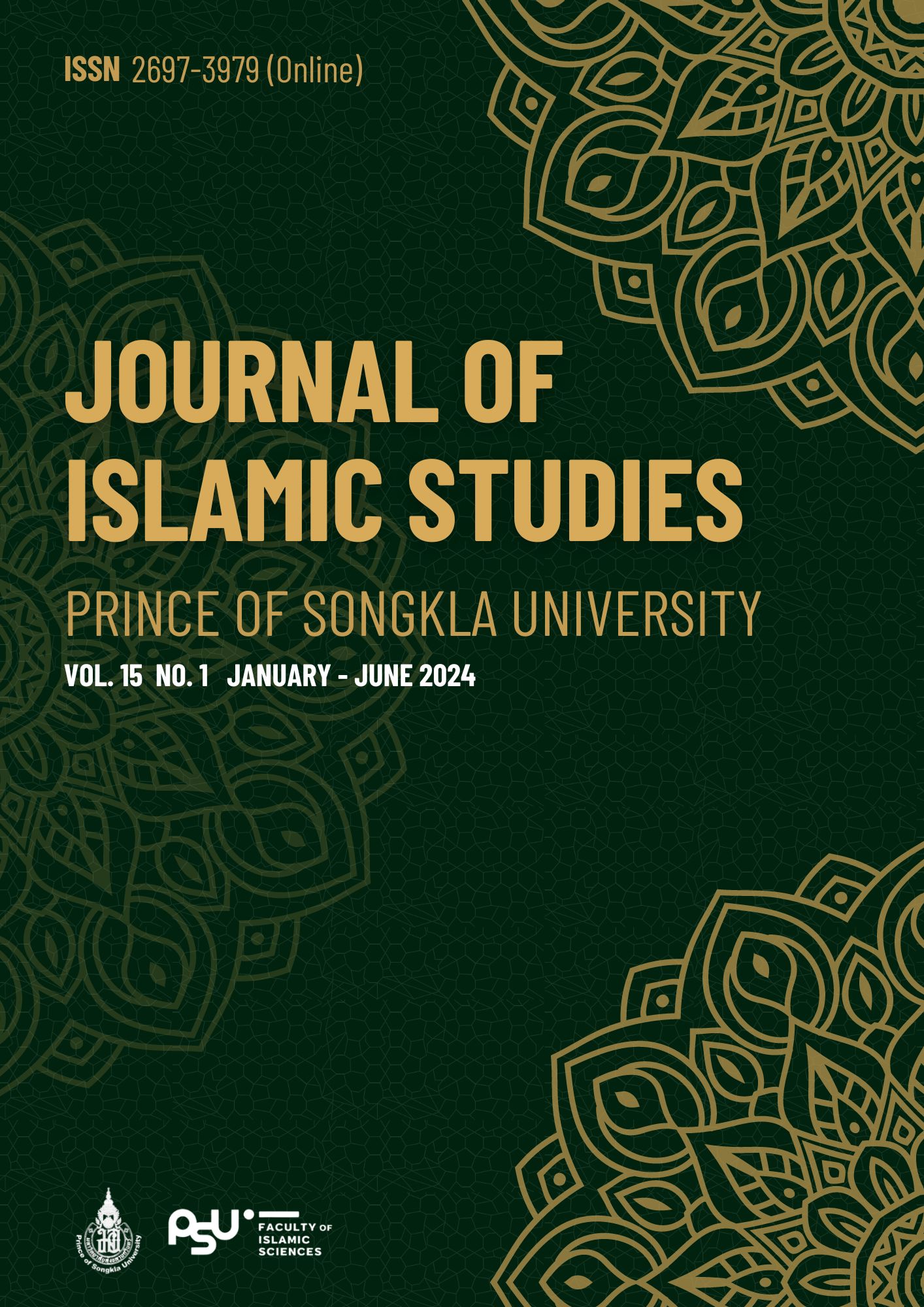ความสัมพันธ์ของมัสยิดกับอัตลักษณ์มุสลิมในกรุงเทพมหานคร: กรณีศึกษาภาษาและวัฒนธรรม
คำสำคัญ:
มัสยิด, อัตลักษณ์มุสลิม, กรุงเทพมหานครบทคัดย่อ
จุดประสงค์ 1) บทความนี้มีจุดประสงค์เพื่อศึกษาอัตลักษณ์มุสลิมในกรุงเทพมหานคร ผ่านการวิเคราะห์ชื่อมัสยิดในพื้นที่ ในแง่ของภาษาและวัฒนธรรม
วิธีการศึกษา บทความเชิงคุณภาพนี้ใช้การวิเคราะห์ความสัมพันธ์ (content analysis) ตีความ (intrepettion) และการพรรณนา (description) ข้อมูลเชิงประจักษ์
ผลการศึกษา มัสยิดในกรุงเทพมหานครผูกพันและสะท้อนอัตลักษณ์ของมุสลิมในพื้นที่ ผ่านการเชื่อมโยงเข้ากับบริบทหลายระดับทั้งในระดับปัจเจก ระดับพื้นที่ ระดับประเทศ ระดับภูมิภาค ระดับโลกอาหรับ และระดับโลกอิสลาม ระดับเหล่านี้แสดงออกในกลวิธีการตั้งชื่อและภูมินาม ในแง่ภาษา เมื่อศึกษาจากกลวิธีการตั้งชื่อมัสยิดแล้ว พบระดับและขอบเขตที่เหลื่อมชั้นไม่เท่ากันภายในชื่อมัสยิดเอง จนนำมาสู่ข้อสังเกตเกี่ยวกับมโนทัศน์ ‘มัสยิดและมุสลิม’ ภายใต้บริบทกรุงเทพมหานคร
การนำผลวิจัยไปใช้ เป็นองค์ความรู้ทางมุสลิมศึกษา และสามารถต่อยอดในการศึกษาเชิงวัฒนธรรมที่เกี่ยวข้องต่อไป
เอกสารอ้างอิง
Aiemueayut, S. (2014). Islamic Anthropology: Introduction and Debates. Social Sciences Academic Journal, 26(1), 91-116.
Angsuviriya, C. (2014). Word structure analysis of food naming in the Southern Thai dialect of ethnic groups in Hat Yai District, Songkhla Province. Journal of Liberal Arts, Prince of Songkla University, 6(1), 17-30.
Bintorleb, A. (2021). ‘Royal-Nationalism Ideology’ in Thai Muslim Society from Absolute Monarchy to 1976. Journal of Human Science, 22(Supplemental Issue), 189-209.
Boonlue, N. (2016). When Malay-Muslim Bangkok and its Suburb have become a part of Thai Society. Rusamilae Journal, 37(1), 64-78.
Boonpanyarote, S. and Naknawa, D. (2023). 5 Mosques, 5 Landmarks in the Inner Bangkok Area: a Case Study of Linguistic and Cultural Landscape to Increase Tourism Value in a New Normal Approach for the Community. Journal of Liberal Arts, Thammasat University, 23(2), 616-639.
Cai, Q., Rerkplian, P. and Jinasot, N. (2022). A Comparative Study of Methods of Classifying Disease Names in Thai AND Chinese. Journal of Social Science and Buddhistic Anthropology, 7(9), 214-328.
Charoenrad, W. (2021). The Names of Mosques in Bangkok: Language and Interpretation of Cultures. Journal of Language and Linguistics, 39(1), 82-100.
Honghengseng, K. (2018). The History of Traditional Thai Color Terms: A Case Study of the Color Green. The Journal of the Thai Khadi Research Institute, 15(1), 1-46.
Honghengseng, K. (2020). History of Ancient Thai Color Terms: A Case Study of Red Tone. Academic Journal of Humanities and Social Sciences, Burapha Universit, 28(3), 287-311.
Honghengseng, K. (2021). The History of Ancient Thai Color Terms: A Case Study of Black and Gray Tone. Journal of Fine and Applied Arts, Khon Kaen University, 13(2), 305-328.
Phothongkham, C. (1998). Naming of Karen People in Suan Pheung Sub District, Suan Pheung District, Ratchaburi Province[Unpublished master’s thesis]. Mahidol University.
Relegious Information Centre. (nd.). Masyid Zahratul Islam. [Image]. Retrieved from https://e-service.dra.go.th/place_page/18465
Samaun, H. (2018). The values and meanings in naming of Thai Muslims with Malaysian race in. Muang District, Narathiwat. Journal of Humanities and Social Sciences, 14(2), 105-143.
Sanasen, W. (2020). Heritage of Ottoman Empire. [Image]. Retrieved from https://readthecloud.co/ottoman-empire-coat-of-arms-tughra
Settanyakan, C. (2022). Cactus Names in Thai: A Study in Botanical Linguistics. Journal of Humanities & Social Sciences, 20(2), 65-87.
Witthayaphirom, K. (2011). The naming of Lavue, ethnic group inPa Pae Village, Mae Sa Riang District, Mae Hong Son Province. Journal of Language and Culture, 30(2), 1-22.
Yusuf, I. (1999). Aspects of Islam in Thailand Today. Isim Newsletter, 3(1), 19-19. https://hdl.handle.net/1887/17276
ดาวน์โหลด
เผยแพร่แล้ว
รูปแบบการอ้างอิง
ฉบับ
ประเภทบทความ
สัญญาอนุญาต
ลิขสิทธิ์ (c) 2024 วารสารอิสลามศึกษา มหาวิทยาลัยสงขลานครินทร์

อนุญาตภายใต้เงื่อนไข Creative Commons Attribution-NonCommercial-NoDerivatives 4.0 International License.
บทความทุกเรื่อง ที่ได้รับการตีพิมพ์ในวารสารอิสลามศึกษาเป็นแนวคิดของผู้เขียน มิใช่เป็นความคิดเห็นคณะผู้จัดทำและมิใช่ความรับผิดชอบของคณะวิทยาการอิสลาม กองบรรณาธิการไม่สงวนสิทธิ์การคัดลอก แต่ให้มีการอ้างอิงแสดงที่มา






